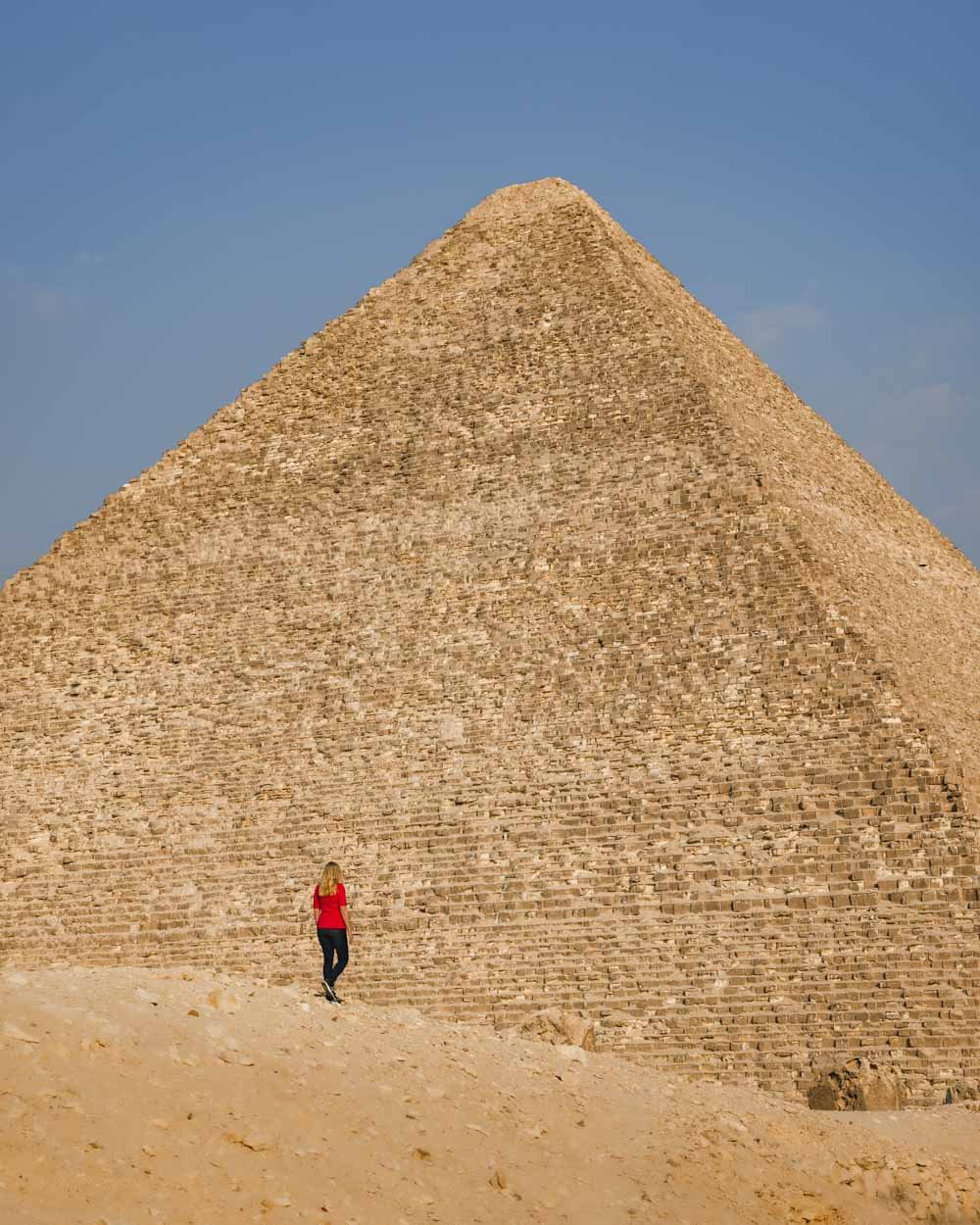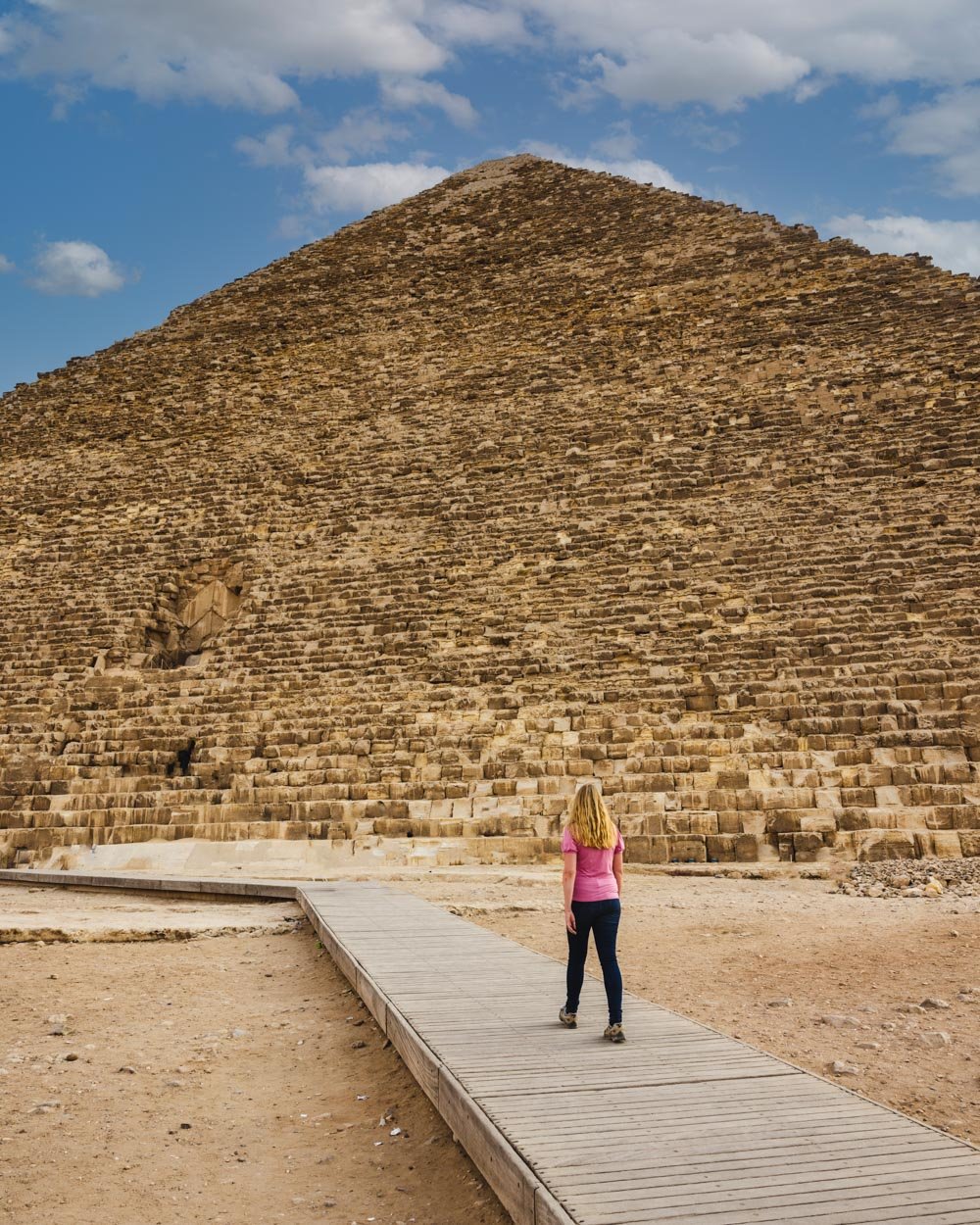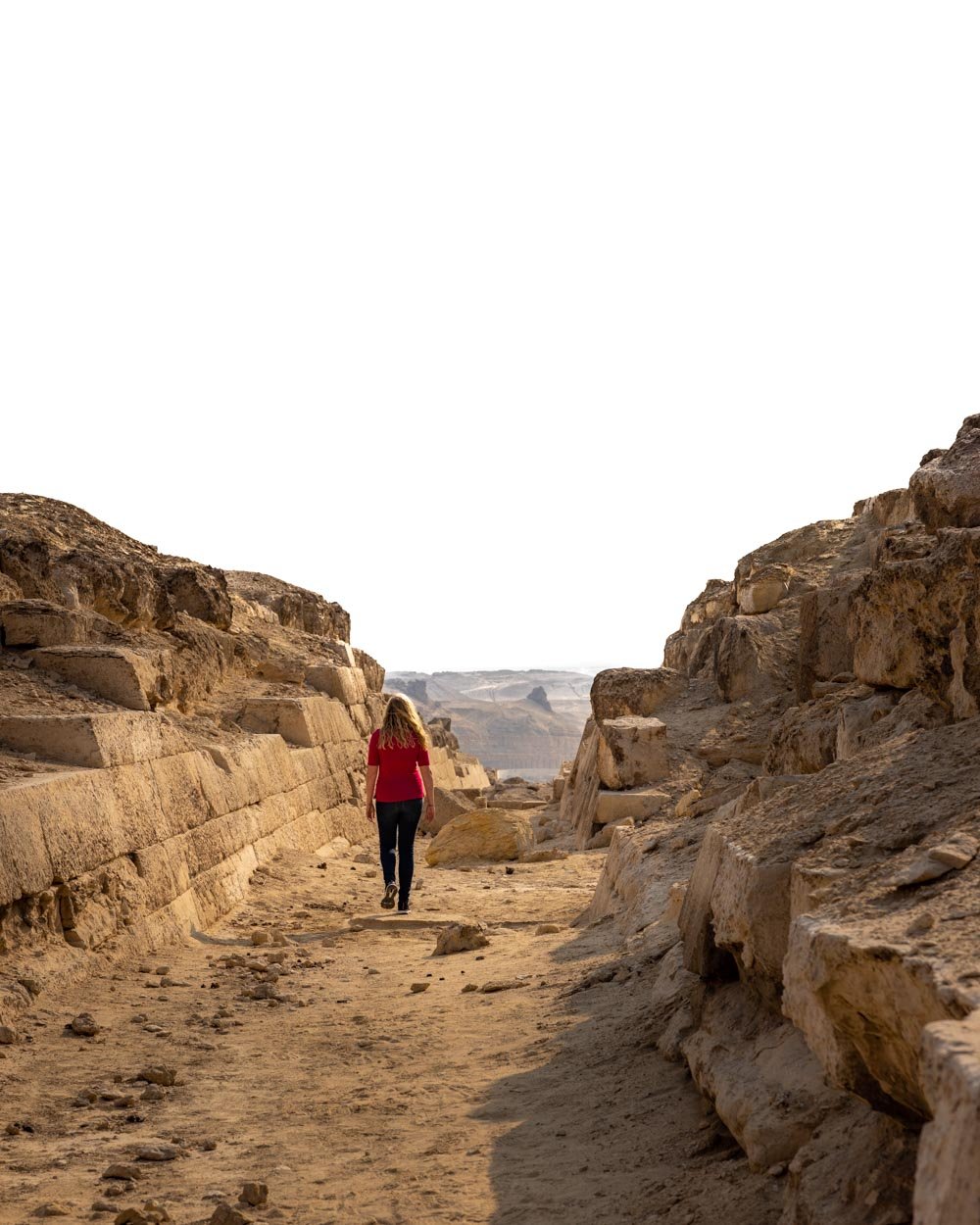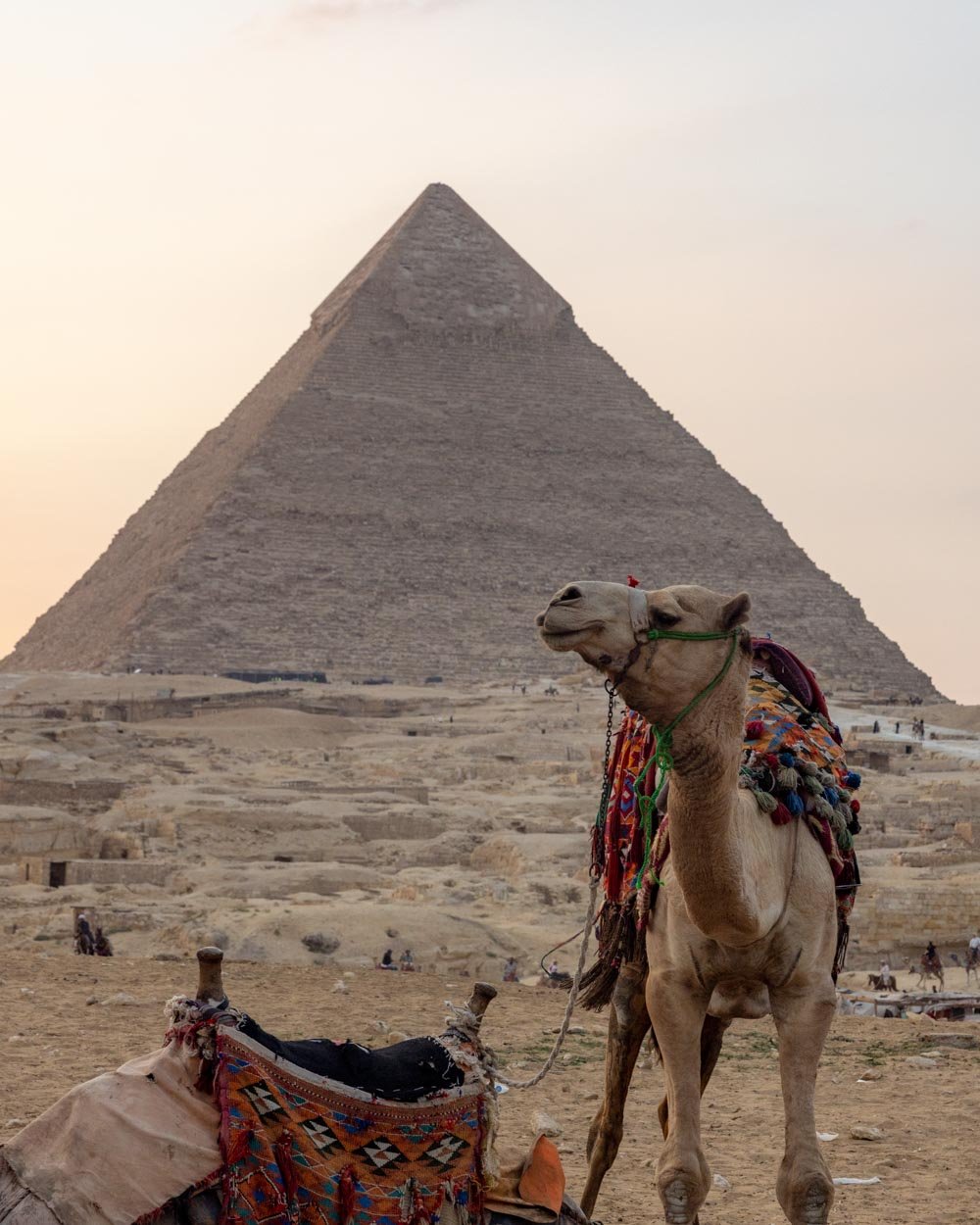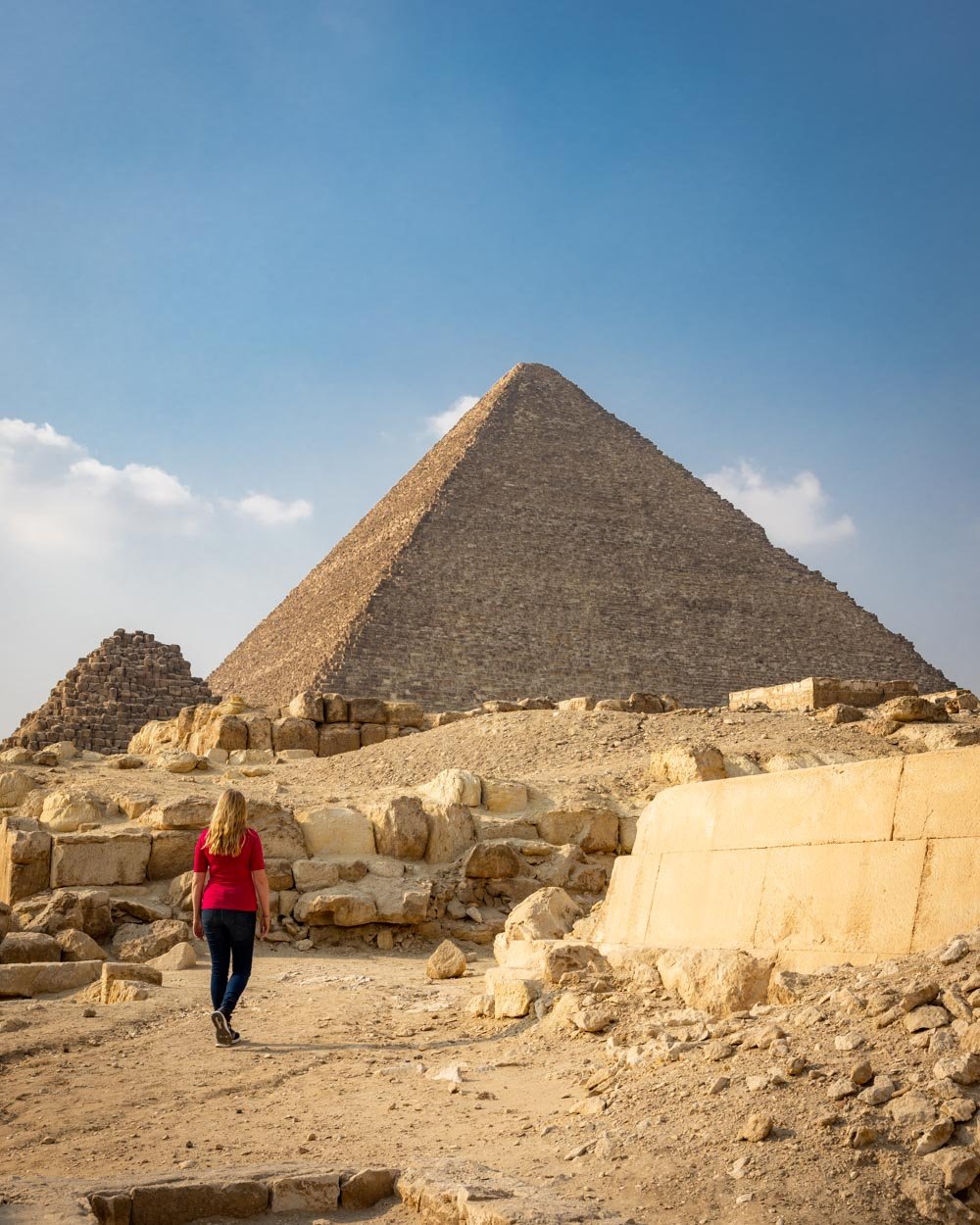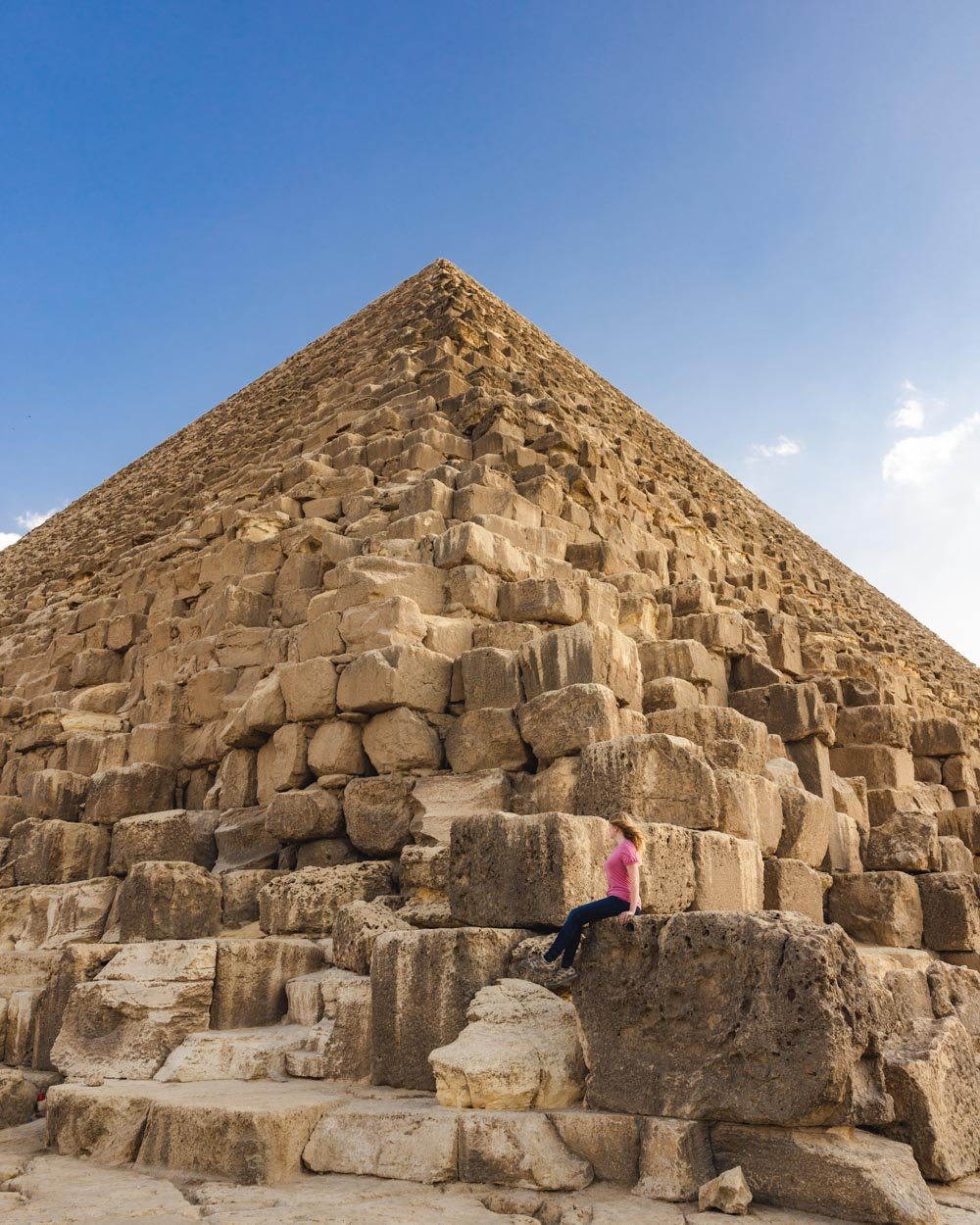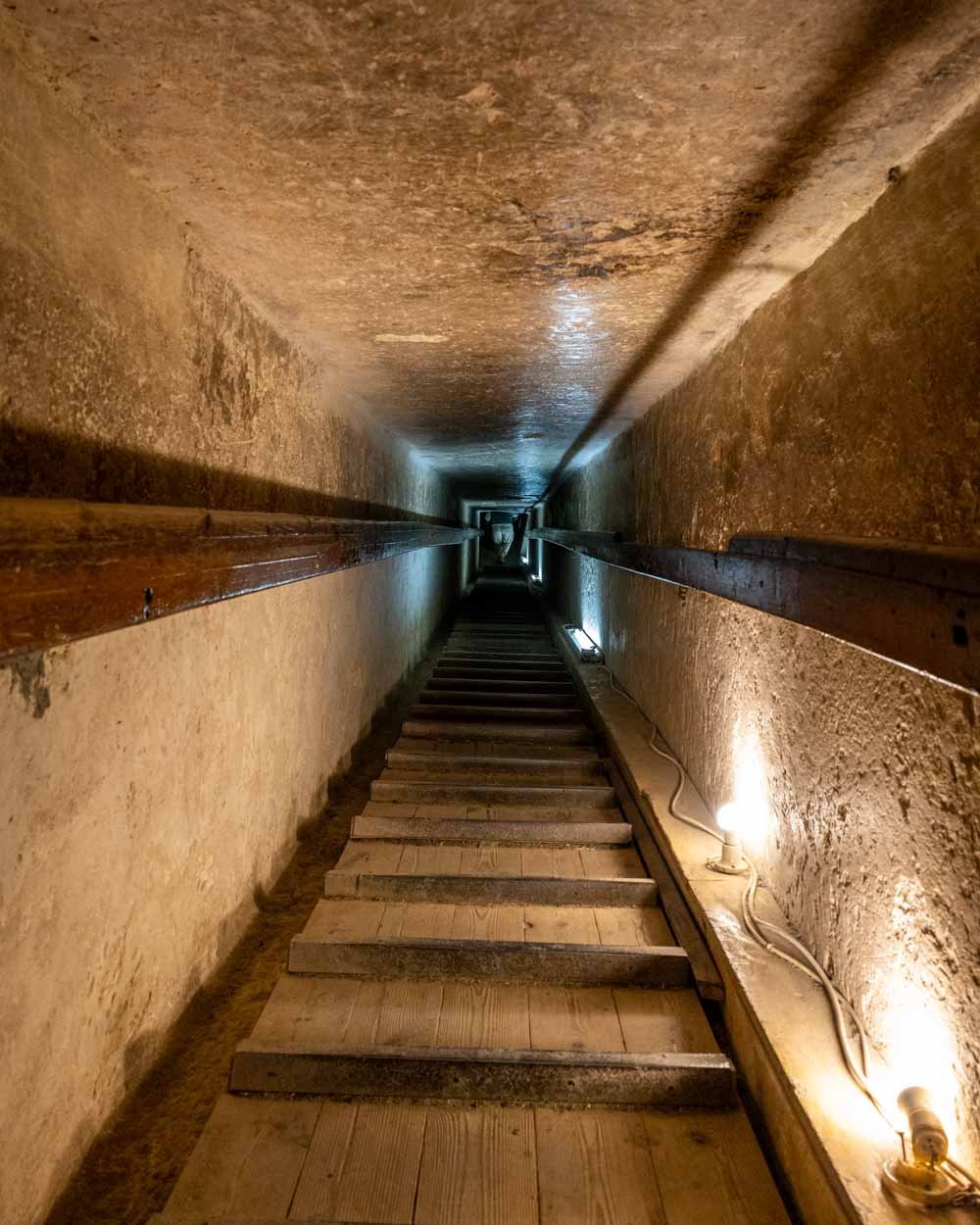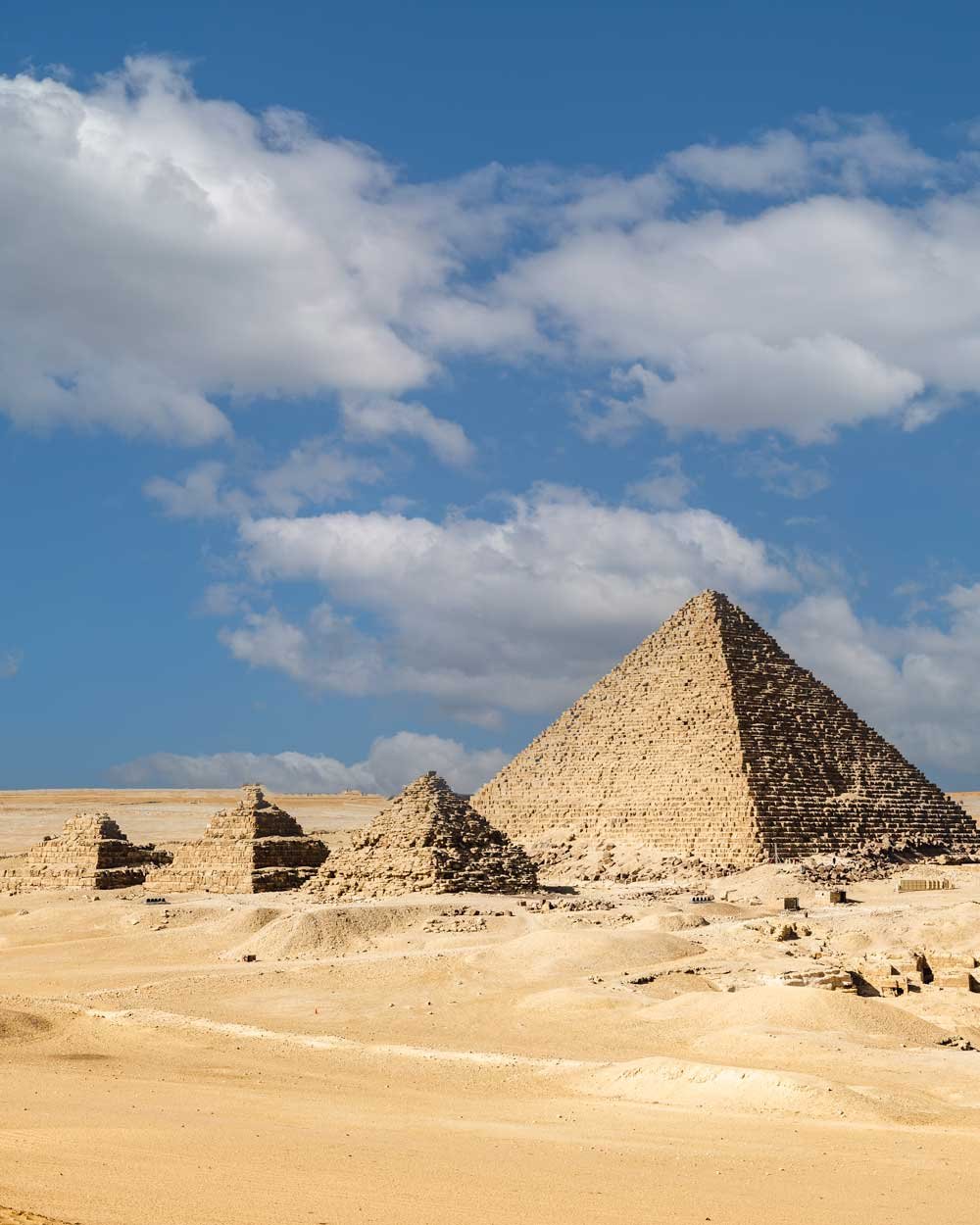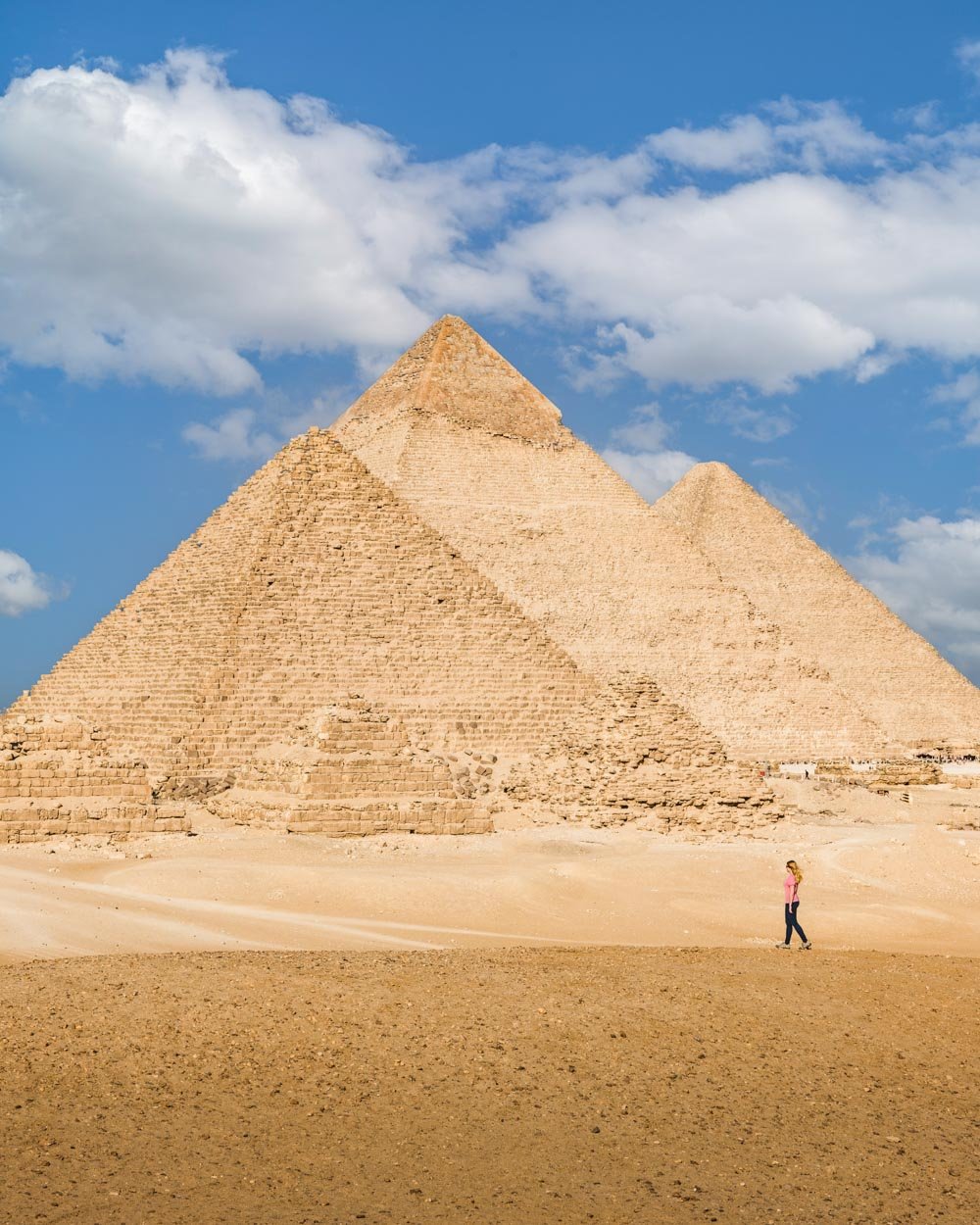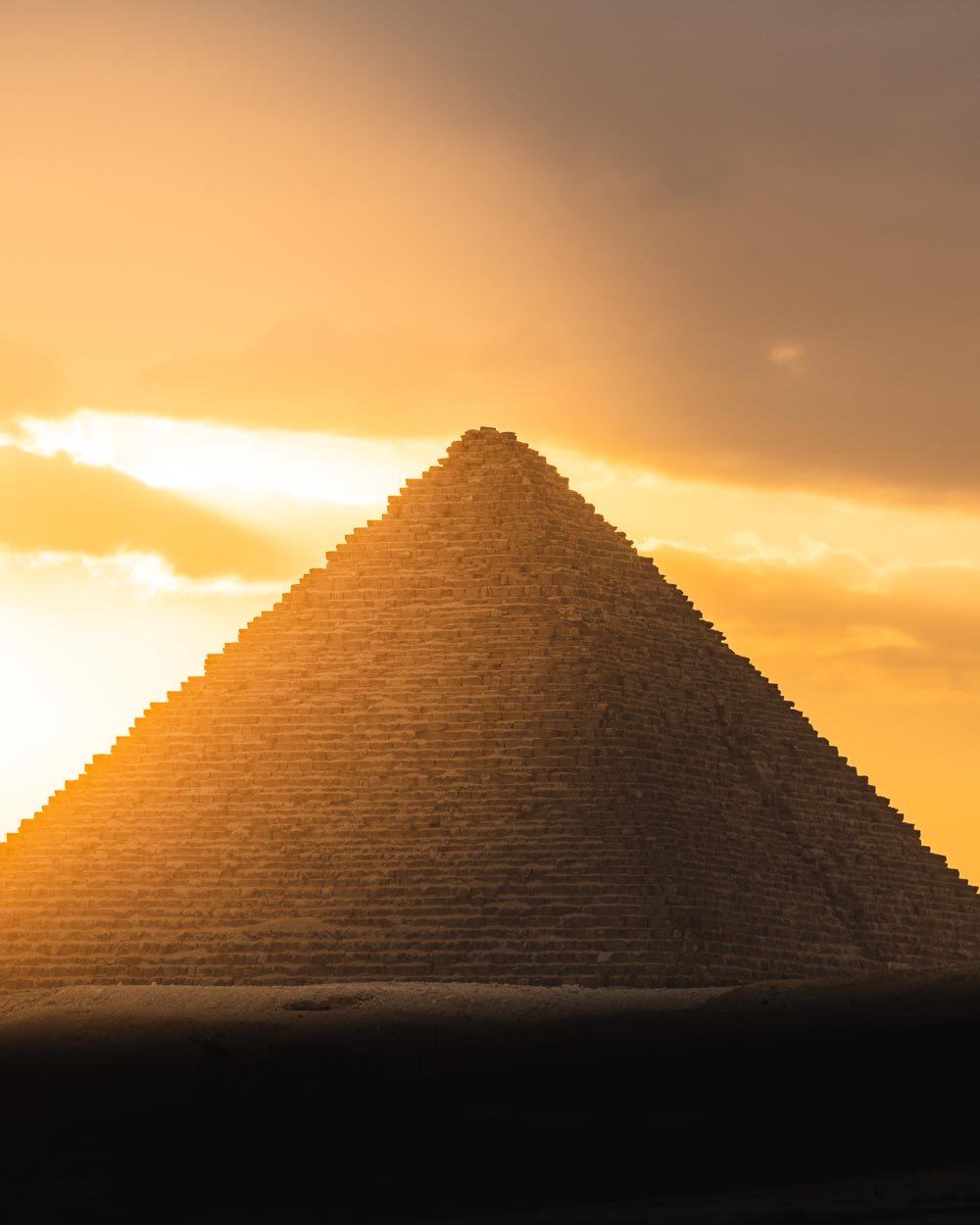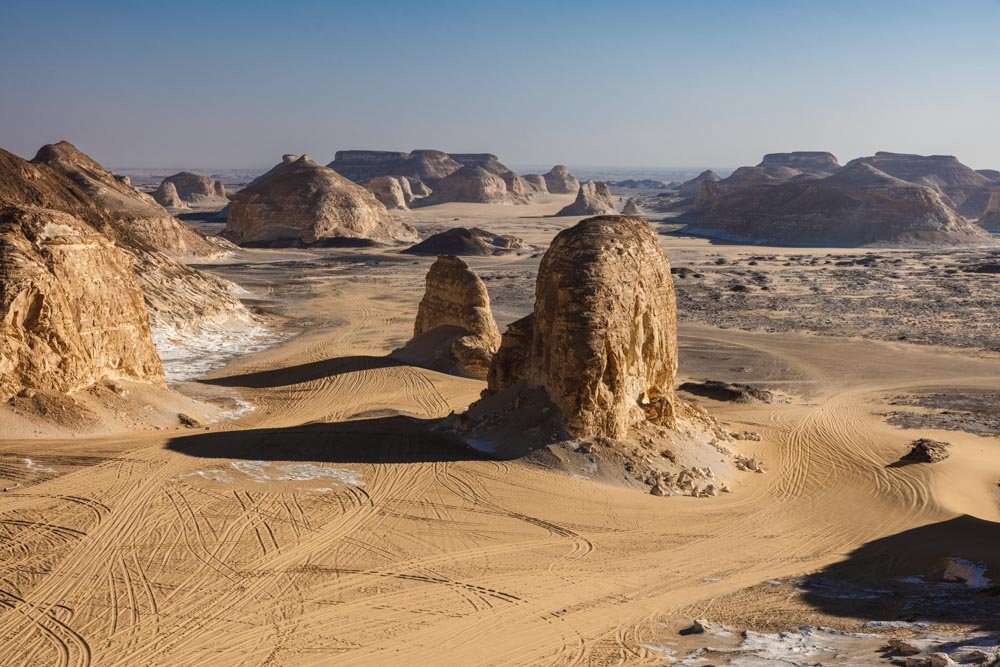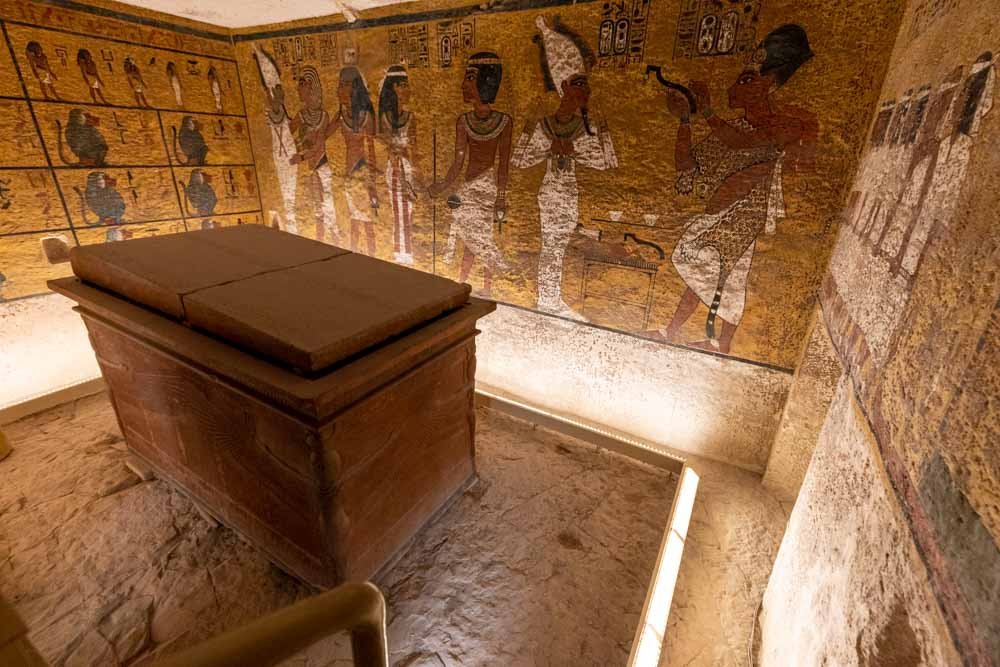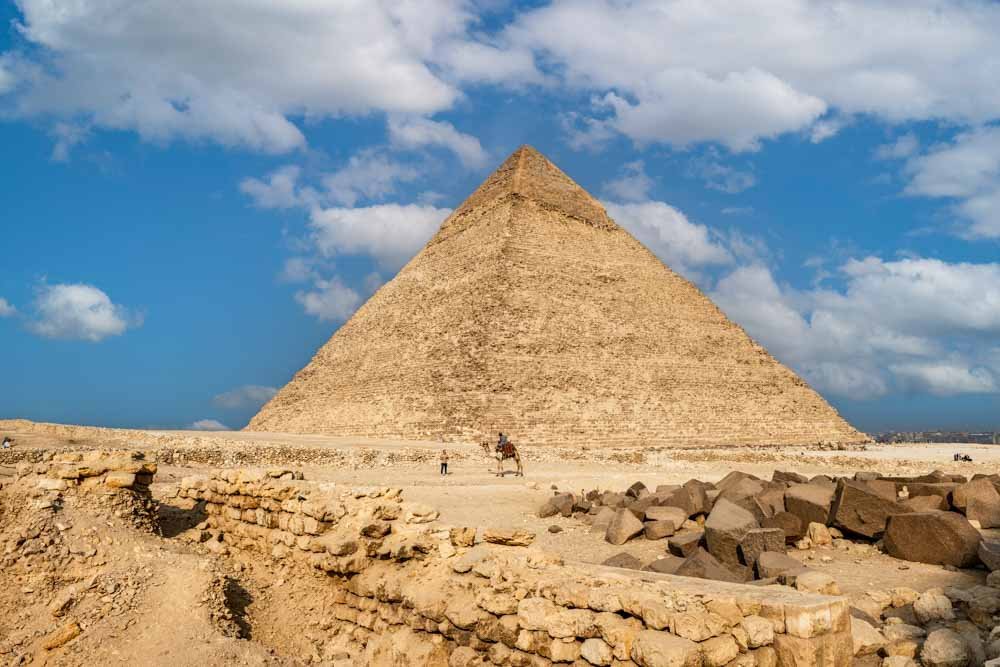The Pyramids of Giza are iconic and visiting them is one of the most memorable travel experiences you can have in Egypt. However, knowing what to see, how to get around, and how much time you need there is not so straightforward if you’ve never been before. There’s more to a visit than simply looking at the Pyramids from the outside, and the deeper you delve, the more you’ll get out of your trip.
We visited the Pyramids three times to bring you this guide which should make planning your day a breeze.
This article will focus on things to do and practicalities, if you want to know about scams and mistakes to avoid at the Pyramids, we have you covered in this article.
Do you need a guide to visit the Pyramids?
The answer to this question is no you don’t. If you’re someone that prefers to do things independently you can absolutely do that here, and each trip we made was without a guide. Many sources will tell you a guide is necessary but honestly, they’re not, it’s only worth hiring a guide if you actually want one.
And if you do hire one, make sure you brief them thoroughly on your interests. Most guides will not really tell you much history and will instead spend most of their time taking cheesy photos of you. Also watch out for being taken to shops masquerading as museums after your visit. Guides make a whopping commission from these visits and you’re the one paying it via the inflated prices.
We contacted many different guides explaining that we wanted someone who would focus on history, and each one sent the same stock answers which predominantly revolved around taking selfies. I am sure there are some great Egyptologists out there, but we certainly couldn’t find one in time!
One thing guides will do is fend off most sellers inside the Pyramids complex itself, however, we didn’t find that necessary. Yes you’ll be offered a camel ride etc when you’re walking around the site alone, but honestly it’s not that bad really. Just say no and walk on. It’s not worth hiring a guide for this reason alone. Read our guide on scams at the Pyramids so you know what to watch out for before you go.
Everything you need to know about visiting the Pyramids
How to get around the site
If you speak to almost anyone in Cairo or Giza, they’ll tell you that you need to take horse and carriage, or camel to get around the site. You’ll be told it’s far too big to walk around it. That is not the case and there are several ways you can get around:
Getting around the pyramids by car
You can hire a driver who can take you very close to almost every single site at the Pyramids. The major sites and viewpoints all have car parks and the attractions are generally within a few minutes walk of each of these car parks.
This enables you to get around the whole Pyramid complex inexpensively and means you don’t need to use animals, which are often very poorly treated.
How much you pay will partly depend on your haggling skills. We were quoted 500 EGP (USD $17) for a half day as a starting point (pre haggle).
On foot
On our third visit to the Pyramids we chose to tackle the site on foot and this was an excellent way to see the sights - I will preface this by saying we were visiting in winter when the temperates didn’t really rise above 25C. If you’re visiting in summer, I wouldn’t recommend it!
It’s easy to visit all three pyramids, the Sphinx and Mers Ankh tomb on foot, This equated to roughly 3km walking and it’s almost all flat. You’re mainly walking on a mixture of pavement and hard ground - we thought there may be a lot of soft sand we’d have to traverse, but it was all compact.
If you want to visit the outer viewpoints then we’d probably recommend a car. The best viewpoint of all (Nine Pyramids Viewpoint) is a few kilometres further on, so it’s going to almost double your walk, and that would be a bit much for most people - especially given there’s very little shade.
The benefit of going on foot is total freedom and it’s a different feeling to being ferried between the sites by car. However, the downside is that you will get more hassle from souvenir sellers and camel riders, although we still found it very manageable.
Assuming you are not staying within walking distance of one of the Pyramids entrances, then it’s best to catch an Uber to the site as it’s much cheaper than using a taxi.
By horse and cart or camel
On the surface this is the most romantic way to get around the site, and I can’t deny watching the horses gallop across the desert was captivating. However, it’s a sad fact of life that the many of the animals at the Pyramids are treated very poorly.
Seeing some of the really scrawny ones with prominent ribs sticking out, dragging a cart up a cobbled road was heartbreaking to say the least. The sound of whips cracking is heard throughout the complex and it always made me wince.
We didn’t look deeply into prices for the service, but if you do want to do it, be prepared to haggle hard.
How much time to spend at the Pyramids
How much time you need will largely depend on how much you’re interested in seeing and how you choose to get around. You could spend as little as a couple of hours if you use transport to get around and don’t want to see all the viewpoints. In a couple of hours with a car you could see all three pyramids, the Sphinx and Panorama Point - that’s if you’re speedy and don’t want to walk around each pyramid for too long.
I would recommend a half day to most visitors. This allows for a leisurely pace, to see all the viewpoints and pyramids, and to go inside one of the pyramid tombs. With a half day on foot you could visit the three pyramids, the Sphinx and Mers Ankh tomb, as well as going inside one pyramid.
If you’re the kind of person that loves to take in details, walk around the base of some of the pyramids and go inside several of the tombs, then you will probably want to allow a full day. Having said that, two half days is better if you can make that work with your itinerary, it is quite tiring getting around the Pyramids and the site is fully exposed to the elements.
Navigating the site
There are two entrances to the Pyramids complex: one by the Great Pyramid and one by the Sphinx. Which one you choose to enter depends on the order in which you want to see things. If you’re planning to visit as soon as the site opens, then your first activity should be the one you care about the most.
For example, if you want an empty picture of the Sphinx, then you should head there first using the Sphinx entrance. If you want to try and nip inside the Great Pyramid before the masses arrive, then that should be your first stop, using the entrance on the northern side of the plateau by the Great Pyramid.
In terms of tickets, you need to buy the general entry ticket, plus any additional tickets at the ticket office at either entrance before you go into the plateau. You can’t buy tickets to go inside the pyramids or the tombs anywhere else but the two ticket offices, and you don’t want to have to backtrack once you’re inside.
For this reason you should decide ahead of time if you want to go inside either of the two pyramids (there are only ever two of the three pyramids open at any one time) and/or Mers Ankh tomb.
Once you’re inside the site, you’ll either have a driver who can take you to each of the spots, or you’ll be making your own way on foot. If you’re on foot it’s best to have a map of the complex on your phone, it’s easy to see all three pyramids and where to head, but it’s not so easy to find Mers Ankh tomb for example.
How to avoid the crowds
This is a tough one because the Pyramids complex is generally a very busy place, especially if you’re visiting in the cooler months of the year. The quietest time tends to be the first hour, which is why we recommend visiting your top spot as soon as the complex opens. We thought it might also empty out later in the day, but that wasn’t the case on any of our visits.
However, it doesn’t mean you can’t escape the crowds at all. Generally speaking people tended to congregate around a few areas, such as the front entrances of each of the pyramids, the temple of the Sphinx and the area in front of the Sphinx.
If you walk a little, you’ll often find the crowds thin out and if you walk right the way around one of the pyramids, you’ll generally find a side or even two where there is next to nobody there. Even beside the Great Pyramid (Khufu’s) you can find a quiet spot if you go looking. The Eastern Cemetary around Mers Ankh tomb was always quiet, which was a real delight.
Things to do at the Pyramids
Explore the Great Pyramid (Khufu’s)
This is the biggie, and the one that everyone will visit. It’s just as impressive as you hope it will be, although slightly less romantic due to the crowds. As mentioned you can walk past the front of the pyramid, where the entrance to the tomb is, and you’ll come to quieter areas.
There is a rope in place around the base of the pyramid though, so it’s not as good for photos as Khafre’s Pyramid (the second largest).
You can no longer climb to the top of the pyramid, but if you want to take a photo perched a few rocks up, you can pay the security guard a little baksheesh. You can see more details in our Pyramids photography guide.
A highlight for us was going inside the pyramid itself. A lot of people will tell you there’s nothing to see and it’s not worth it. They’re right about the nothing to see part, the tomb contains a plain sarcophagus and there isn’t a painting in sight. The Valley of the Kings it isn’t. However, when it comes to going inside a pyramid, it’s best to listen to that old adage - it’s about the journey, not the destination.
The journey takes you into the very depths of the Great Pyramid. It’s hot, sweaty and claustrophobic at points, but you’re clambering up into the very heart of the pyramid and that to me was very exciting.
You can read more on exactly what going inside the pyramids is like in our detailed guide (which includes some rarely visited pyramids too, which were a lot more adventurous).
Exploring Khafre’s Pyramid (the second largest)
The second largest pyramid should be next on your hit list. This one is also very impressive and again, walking around the base will see you escape the crowds.
The best side for photography is the western side because there is rubble in front of most of the rest of the pyramid, and the area around the main entrance is usually busy.
Unlike the Great Pyramid tomb, Khafre’s tomb will only be open if the Pyramid of Menkaure’s tomb is closed (as they alternate between them). Khafre’s Pyramid was open for us and we enjoyed venturing inside.
It’s a bit easier than the Great Pyramid, but the tomb was a bit of a free for all with people taking selfies inside the sarcophagus, which was a bit of a surprise (the tomb guardian in the Great Pyramid did not allow this).
I was still glad to have seen the inside, but I’d recommend going in early and trying to escape the crowds if you don’t like the idea of sarcophagus selfies!
Exploring the Pyramid of Menkaure
The smallest pyramid, the Pyramid of Menkaure, sits closest to the edge of the desert (but still within easy walking distance of Khafre’s Pyramid).
Its slightly further out location means it generally sees fewer visitors than either of the other two pyramids. It is smaller, so slightly less impressive than the other two, and does have some stone cladding at the bottom, which isn’t quite as picturesque, but we still enjoyed seeing it up close.
Unfortunately the tomb was not open, so we can’t really give any tips about that. My guess is that it would be a much quieter experience.
Exploring the Sphinx
Ah, the Sphinx. An incredible sight, but a less than stellar experience unless you go early in the morning. Both the front and side view of the Sphinx get incredibly busy and you can’t avoid the crowds by walking around the base like you can with the main pyramids. The only trick to serenity here is to come when the complex opens.
Do not hit the side Sphinx view (which you reach by walking through the Sphinx temple) in the afternoon. That is unless you want to be part of a huge mass of people kissing the Sphinx, making the Sphinx smoke a cigarette, punching the Sphinx, or making the Sphinx kiss their bum… you get the picture!
Come first thing and the Sphinx is a marvellous sight, both from the front where you get it nicely framed by Khafre’s pyramid, and the side where you get to see it up close.
Unfortunately unless you’re on an exclusive tour you can’t walk down to the Sphinx anymore. On my first visit to Egypt many years ago a bit of baksheesh would get you down, but no longer (or that didn’t work for us anyway!).
Mers Ankh tomb
Mers Ankh tomb was an unexpected treasure for us. We had no expectations for visiting and it turned out to be one of our favourite stops. Now in terms of the tomb itself it’s not on par with those in Luxor, however it’s still impressive and you’re likely to be the only one inside - they had to unlock it for us!
Inside the small tomb you’ll find paintings and reliefs showing scenes of daily life, as well as some large stone statues.
There’s also a stairway down to the burial pit.
However, it’s not just the tomb itself which we enjoyed, it was the area surrounding it. The truth is that the Eastern Cemetery beside the tomb was the only time that exploring the Pyramids felt like how you dreamt it would be. The three small crumbling pyramids beside the cemetery were deserted.
You could wander the ruins with views out to the Great Pyramid, not to the backdrop of ‘you like camel? You want camel ride?’, but to the sound of silence.
Well maybe not silence, this is still Giza, and you’ll hear the constant honking of car horns, but you’re otherwise alone. It was a truly memorable experience.
As a side note, you can also visit the Tomb of Qar before you reach Mers Ankh, it’s free to enter and worth a quick peek (you’ll find it on Google Maps by clicking here).
Nine Pyramids Lounge
The Nine Pyramids Lounge sits within the pyramid complex, so you’ll need an entry ticket to visit. It’s located several kilometres from the Great Pyramid, so it’s best reached by car. You may be stopped on the road in by security and asked for some baksheesh in order to pass.
Tell them you have a reservation (even if you don’t) and slip a small amount of cash in Egyptian currency.
You’ll then arrive at a large restaurant which does local food with a wonderful view of the Pyramids. However, it wasn’t the main restaurant we came for, it was the amazing Bedouin section in front of it (run by the lounge).
The brightly coloured low cushioned seating offers one of the best views of all nine pyramids. It’s truly mind blowing and a real pinch yourself experience. To use the seating you only need to buy drinks, but you can also buy food if you want to (it was ok, nothing to write home about).
You cannot reserve the seats, but we didn’t have to wait long to snag a great spot on the front row.
The viewpoints
Nine Pyramids View
Our favourite view was the one at, and just beside Nine Pyramids Lounge. If you don’t want to buy anything from the lounge you can still go to the viewpoint just beside it (not the Bedouin seating area). You’ll get an expansive view of all nine pyramids (3 are crumbling away) and the vast rolling desert. It’s a must see.
The Six Pyramids View
This was our second favourite view in the complex. You can see the three main pyramids sort of stacked on top of each other, which is very dramatic. It’s not an official viewpoint as such, but to reach it, park at theses coordinates: 29.9678686, 31.1258112 (you can click here to see it on Google Maps) and then walk towards the small hill (less than a five minute walk).
You can also have someone walk down the hill onto the next crest to add some scale to the picture.
Panorama Point
This is the most well known and popular viewpoint. It does offer a great view, but it comes with its downsides. There are lots of trinket sellers and people trying to get you to take a camel ride, not to mention crowds.
You can park right beside it and it’s definitely worth a visit, but it’s our least favourite of the three viewpoints.
If you’d like to see the Pyramids from other vantage points around the site and Giza in general, we have a whole guide on the best Pyramid photography spots.
Sunrise and sunset at the Pyramids
Sunrise and sunset photography inside the complex is tricky due to the opening times, which don’t allow you inside at these times at any time of year. There are sunrise or sunset tours into the desert you can take, which have views back to the Pyramids. However we also found something of a work around if you’re visiting during winter opening hours, between October and March.
We really wanted to watch sunset at the Pyramids, and when I started asking around I was universally told I needed to take a sunset tour, this was backed up by articles I read online. This was not the case for us and we visited twice at sunset because the close time was relaxed and we weren’t asked to leave until 40 minutes after the official closing time (and even then there was no real pressure to leave until a bit later still).
However, if you’re like me and super keen to see a sunset, then you might not want to rely on the relaxed close time we got in case you don’t get so lucky. For this reason my advice would be to aim to be at the furthest of the three main pyramids (Menkaure) at closing time. You can then slowly walk back towards the Sphinx (an ideal sunset spot) and watch the sun set as you go.
You will also be offered the chance to go into the desert by horse or camel, and this is allowed outside the Pyramids opening times. We were offered the price of 200 EGP for a sunset camel ride (USD $32 less than tour companies were offering).
We declined because we didn’t want to ride a camel, but we could probably have just paid to be allowed to go to the area on foot. In the end we got almost the full sunset at the Sphinx, so we didn’t need this option.
In essence, the point is that there are ways and means, so don’t feel you have to book one of those expensive tours if you don’t want to. Test out your options on the ground and as always, be prepared with a little baksheesh.
Facilities at the Pyramids
There are plenty of western style flush toilets scattered throughout the complex. There are no restaurants beside the Nine Pyramids Lounge inside the complex, but there are drinks sellers.
You can also find lots of restaurants just outside the Sphinx entrance. Some of these such as Cleopatra View Hotel beside Pizza Hut run scams (overcharging) so watch out for that.
Where to eat by the Pyramids
Our two favourite options are at opposite ends of the price scale, and we actually recommend them both equally. At the budget end we loved El Gizawy Falafel, it might look super basic, but the food was some of the best we had in Egypt.
I opted for a variety of veggies, falafel and bread which was really tasty, and the baba ghanoush was the best I have ever had in my life! Prices are very low, you can eat well for a few dollars. Joe had the meatballs and also loved it, as did Joe’s parents. Between us we tried most of the dishes and there wasn’t a dud in the mix! You can find it on Google Maps here.
Our next recommendation is Marriott Mena Hotel. They have a variety of restaurants inside. We tried the Indian and Italian and both were good. They are much pricier as it’s a five star hotel, but it’s worth visiting the hotel at least once for the wonderful pyramid views alone.
Opening times and entry fees
At time of writing the Pyramids are open:
Summer (April - September): 8am - 5pm
Winter (October - March): 8am - 4pm
Last admission is one hour before closing.
The pricing is as follows:
Area Entry - 240 EGP
Entry inside Khufu’s Pyramid - 600 EGP
Entry inside Khafre’s Pyramid - 100 EGP
Entry inside Mers Ankh Tomb - 50 EGP
Where to stay in Giza
Guardian Guesthouse
Few hotels in the world have a view that can rival Guardian Guesthouse. Situated just metres from the entrance to the pyramid complex, the best rooms here have head on Sphinx views, with the pyramids behind it. Sunset from the room is simply magical and you can even get a free glimpse of the sound and light show in the evening from the hotel rooftop.
It’s also one of the few places in Giza that is almost entirely away from the car horns and engine noise of Giza, as it’s tucked away beside the Sphinx, which is completely dead when it’s closed. The rooms are dated, but clean and comfy enough.
Marriott Mena House
The Marriott Mena is what pyramid dreams are made of. This historic hotel is situated within walking distance of the entrance to the Pyramids and has hosted some of the most famous people in the world, including US Presidents, movie stars, writers and musicians.
The view from the grounds are spectacular, with Khufu’s and Khafre’s pyramids overlooking the green oasis of Mena House.
If you’ve got the budget, this is the place to stay in Giza.
This post may contain affiliate links, meaning at no additional cost to you, that we will earn a small commission if you click through and decide to make a purchase. This helps towards the costs of running our website. Thanks for your support!


